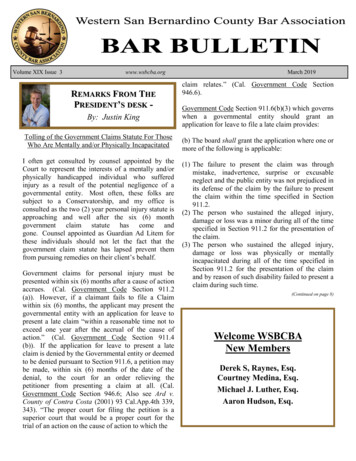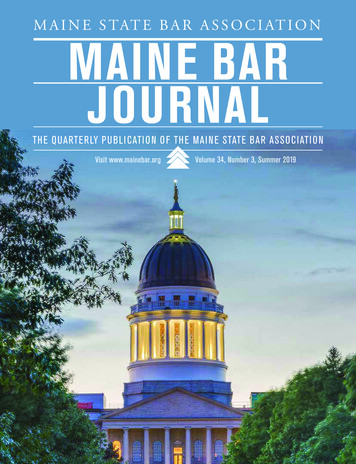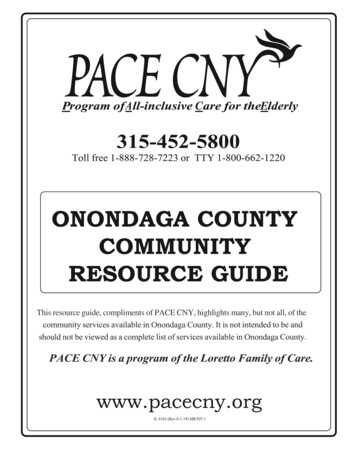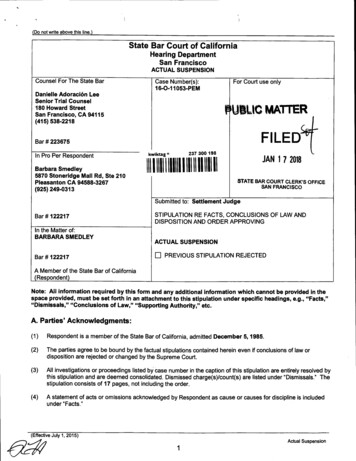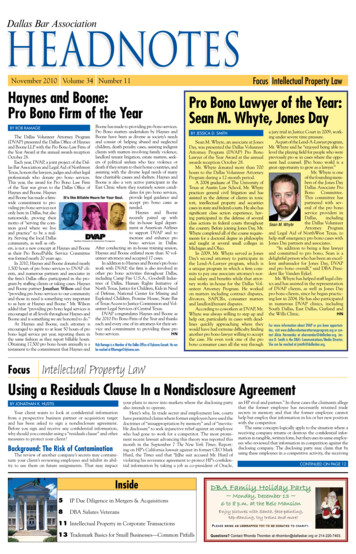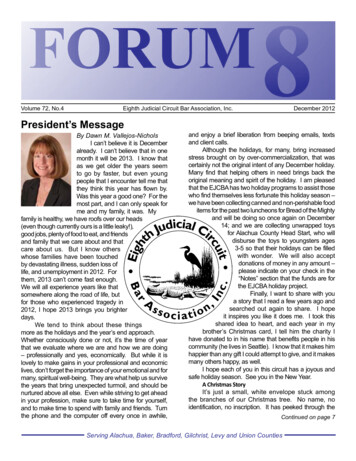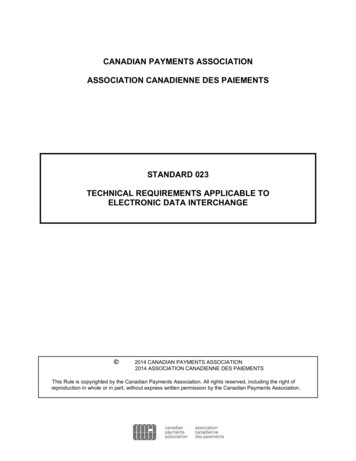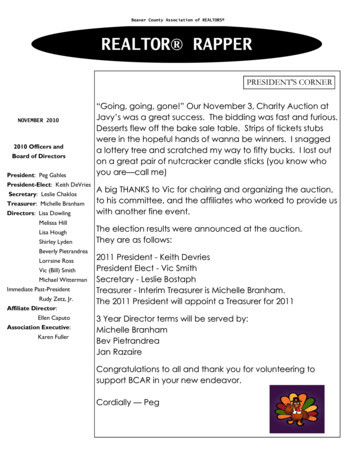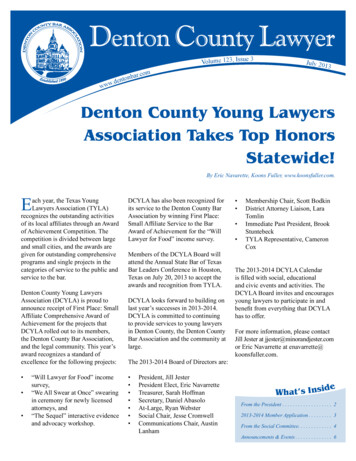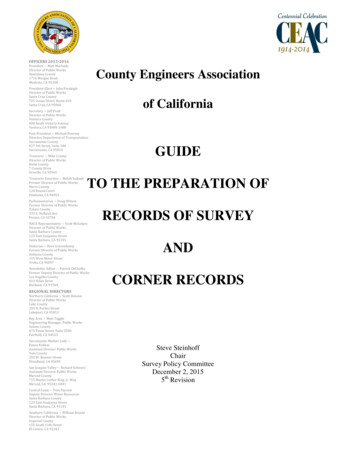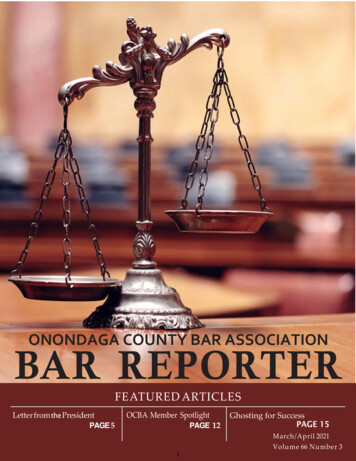
Transcription
ONONDAGA COUNTY BAR ASSOCIATIONBA R R E P O RT E RFEATURED ARTICLESLetter from the PresidentPAGE 5OCBA Member SpotlightPAGE 12Ghosting for SuccessPAGE 15March/April 2021Volume 66 Number 31
Onondaga County Bar AssociationCNY Philanthropy Center431 East Fayette Street, Suite 300Syracuse, NY 13202315-471-2667Our Mission:To maintain the honor anddignity of the professionof law, to cultivatesocial discourse amongits members, and toincrease its significancein promoting the dueadministration of Justice.2
PresidentPaula M. EngelPresident-ElectDanielle M.FogelVice PresidentGraeme SpicerTreasurerMartin A. LynnSecretaryLaura L. SpringImmediate Past PresidentAaron J. RyderDirectorsStaci Dennis-TaylorCrystal M. DoodyHon. Matthew J. DoranKevin T. HuntBrandon R. KingJenna W. KlucsikJimmie C. McCurdySamantha L. MillierSarah C. ReckessRamon E. RiveraAnastasia M. SemelRobert J. ThorpeSubhash ViswanathanJennifer L. WangRobert C. WhitakerEx-OfficioDean Craig M. BoiseJean Marie WestlakeStaffJeffrey A. UnaitisExecutive DirectorCarrie ChantlerThe 1,200 member Onondaga County Bar Association was founded in 1875. Among itspurposes are: to maintain the honor and dignity of the profession of law; to promotesuitable reforms and necessary improvements in the law; to facilitate the administrationof justice; and, to elevate the standards of integrity, professional competence, andcourtesy in the legal profession.3Marketing & Communications DirectorMaggie JamesAdministrative Professional& Lawyer Referral Service Manager
Stewart Title Insurance Company is seeking candidates for the following positions:Title Insurance Examiner - UnderwriterStewart Title is seeking Title Examiner and Underwriter candidates with related realproperty title experience to join our expanding team in Upstate NY. Title examiners andunderwriters examine real property titles, analyze title risks, prepare title reports andcommitments for insurance, and partner with our customers in all facets of insured titletransactions. 2-5 years of experience working with real property titles is desirable. A lawdegree is a plus. Strong analytical and interpersonal skills, and a drive to provideexcellent customer service in a fast-paced environment are required. We will providetraining to expand a successful candidate’s knowledge and skills in real propertytitle. Various work locations possible. For more information and to apply, please clickhere: Apply Stewart Title Examiner or Apply Stewart Title UnderwriterTitle Insurance ProcessorStewart Title is seeking title insurance processor candidates with a minimum of 2-5 yearsof related real property title experience to join our expanding team in UpstateNY. Associates in this position provide administrative support for title examinationfunctions and facilitate title insurance application processing at various points for titleinsurance policies. Strong organizational and interpersonal skills, and a drive to provideexcellent customer service are required. We will provide training to expand a successfulcandidate’s knowledge and skills in real property title. Various work locationspossible. For more information and to apply, click here: Apply Stewart Title Processor.4
Dear ColleaguePaula M. Engel, Esq.When the revelations came fast and frighteningly in the #MeToo#TimesUp, post-Harvey Weinstein period, I listened with horror tomy colleagues’ descriptions of their own encounters at work withdiscrimination and harassment. The perpetrators were, more oftenthan not, male superiors, but gender discrimination can and doesflow from and to all directions, to sys- or trans-gendered women, topeople whose gender identities are fluid or non-binary.In 2018, the American Bar Association published the results of aground-breaking study, “You Can’t Change What You Can’t See.”1 The report revealed that a quarter ofwomen surveyed reported that they had encountered unwelcome sexual harassment at work,including unwanted sexual comments, physical contact, and/or romantic advances. Sexist comments,stories and jokes appear to be widespread in the legal field, with more than 70 percent of all groupsreporting encountering this type of activity in the workplace.Now, with the allegations against our state government’s chief executive officer, we are reminded yetagain that advances like those described in the news these past few weeks are really “not about sex.It's about power and aggression and manipulation. It's an abuse of power problem," says JamesCampbell Quick, PhD, a professor of leadership and management at the University of Texas atArlington. I have heard men claim in their defense, “She didn’t say no, not once.” Often, no justice isrealized because a law enforcement agent agrees with that position – without a clear, negativerejection of the advances from the victim, no crime could be successfully prosecuted. The powerremains with the abuser, the victim becomes victimized again for not doing enough to stop the assault.Hearing those victims’ calls for justice land on deaf ears is so disheartening. So many abusers leveragetheir victims’ dramatically uneven power positions, other victims are inebriated or unconscious orcognitively impaired: these are people who – from fear for their jobs or by reason of incapacity –cannot find the way to say “no” or “stop.” Is the abuse they endure any less horrific or damaging?In 2014, California passed the “Yes Means Yes” law. The law went further than the common "no meansno" standard, which has been blamed for bringing ambiguity into investigations of sexual assault cases.The added component of that state’s Education Law requires all levels of colleges, public or private, tohandle rape and sexual assault accusations with the requirement of an "affirmative consent" andstating that consent can't be given if someone is asleep or incapacitated by drugs or alcohol. “Lack ofprotest or resistance does not mean consent," the law states, "nor does silence mean consent.Affirmative consent must be ongoing throughout a sexual activity and can be revoked at any time." OnJuly 7, 2015, our state followed suit by adopting a new Article 129-B to the New York State EducationLaw, among other changes.5
Other steps were adopted in the past few years. By October 1, 2018, every New York State employerhad to implement a sexual harassment policy and provide training for its employees. The training Ireceived in my department was developed by New York State government and clearly demonstratedthat no one can take someone’s silence or even nervous laughter as consent to physical or verbalcontact that is sexual in nature or has the effect of gender discrimination. But as someone who writesand provides training on human resources policies, it is obvious that a few pages of written words anda PowerPoint presentation will never be enough to change a dynamic that permits these hostile anddiscriminatory actions in our workplaces.The Olsen Group, a human resources consulting group, lists seven ways to reduce genderdiscrimination in the workplace:(1) Build diversity from the inside out. One way to provide better balance and opportunity is toeliminate years of experience requirements, which tends to marginalize attorneys who have stayed athome to care for children or sick relatives. Read the excellent essay from Bryn Lovejoy-Grinnell on page15 on how to set boundaries, and think about how to empower attorneys in your firm to do the samewithout fear of losing opportunities for professional advancement.(2) Bring men into the fight. Companies should educate male employees on gender barriers andencourage them to help their women colleagues combat these obstacles. If you are a senior partner,why not serve as a mentor to a person of a different gender than your own.(3) Teach employees about what is NOT sexual harassment. It’s just as important that you teach yourstaff what behaviors are not considered sexual harassment. Encourage male employees to ask femalecolleagues on a coffee run, or to join them for lunch, and assure them that this is not harassingbehavior. Including women in social events helps to promote a greater sense of gender equality in theworkplace.(4) Establish networking initiatives that include all genders. Create networking strategies that includeall employees. Firm outings, picnics, client dinners should include attorneys of all genders.(5) Require and Practice Social Inclusion. As mentioned above, the risk of focusing on preventingsexual harassment and discrimination in your law office is that women will be excluded. That is not thesolution. If you are generating firm-wide opportunities (number 4), then social circles that include allgenders will become the norm. Be aware of the message it sends to some employees that a group ofmen in the office travel to the NCAA tournament every year, or that the managing partner plays golfonce a month with three associates, all of whom are male.(6) Educate employees on how to handle workplace romance situations. Train employees on how toeffectively ascertain real consent from a co-worker, and how to keep personal relationships fromimpacting the work environment.(7) Eliminate the secrecy surrounding workplace romances. Too often, people believe they are doing agreat job hiding their relationship when in fact, everyone knows what is going on. Require that allemployees disclose the workplace relationship to their managing partner, so that boundaries can bediscussed and reinforced, and if need be, changes in assignments are made if the attorney is a directreport of the other person in the relationship. While it may foster secrecy, there is a cogent argumentfor prohibiting any romantic relationships between supervisors and a direct subordinate. The powerimbalance in many cases, at best, will send an unwelcome subliminal message that the attraction may6
lead to better job opportunities, or at worst, will explode into workplace drama and potential lawsuits.Even changing departments, if the relationship is known throughout the firm, may not be enough tomitigate those risks.I would add an eighth item to this list: Improve your policy regarding workplace discrimination orharassment, by instilling confidence that reporters will get prompt responses and will never faceretaliation. Take a look at the summary of the paper developed by Sarah Ruhlen and Diane Williamsonon Workplace Bullying on page 18 on the different ways in which employees can be disenfranchised bya hostile work environment.Who didn’t read with dismay just a few months ago about the long wait endured and the extra effortsneeded by a court clerk in the Onondaga County Family Court system to get some level of response toher complaint about a superior’s unwelcome advances? In a study released this past November, theNew York State Judicial Committee on Women in the Courts released its first study on genderdiscrimination in our judicial system since the 1980s. Regarding the reporting of sexual harassment inall its forms, only 31 percent of female respondents and 49 percent of male respondents indicated theyknew how, when and where to report a claim related to misconduct in a Unified Court System facility.The Onondaga County Bar Association’s Diversity and Inclusion Committee, co-chaired by SarahReckess and Staci Dennis-Taylor, is working with the Honorable Deborah J. Karalunas and otherdedicated attorneys to address these and other issues to improve gender equality in our judicialdistrict. We encourage everyone to support and adopt their best practices and recommendations tocombat gender discrimination and harassment in our offices.The “good ole boy” mentality, where the wagons circle to protect those in power, creates the kind ofenvironment that permits abuses to continue, to the detriment of all of us. This isn’t just a “woman’sissue,” it is about providing safe workplaces. A toxic work environment can lower productivity andincrease turnover and absenteeism, with employees less engaged in their work. “A hostileenvironment affects the whole organization, not just the people who are harassed," says ChrisKilmartin, PhD, a psychologist and emeritus psychology professor at the University of MaryWashington. "Basically, it poisons the organization."21“You Can’t Change What You Can’t See: Interrupting Racial & Gender Bias in the Legal Profession (executive Summary).”Accessed on March 15, 2021 at int.pdf. The study was conducted by the Center for Work Life Law at the University of California,Hastings College of the Law on behalf of The Minority Corporate Counsel Association (MCCA) and The American BarAssociation’s Commission on Women in the Profession.2Smith, B. “What it really takes to stop sexual harassment.” Monitor on Psychology (American Psychology Association,February 2018, Vol 49, No. 2). Accessed March 15, 2021 at ent.7
Statement from the OCBA Board of DirectorsOn Rise in Violence and Hate Speech Directed to theAsian American and Pacific Islander CommunitiesThe Board of Directors of the Onondaga County Bar Association joins with ourpeers across the nation in condemning the racism and hate that has propelled analarming and dramatic increase in attacks and slurs against our Asian Americanand Pacific Islander community members over the past year (reports are that suchattacks in New York State have risen between 150% to 800% or more).All of us should do our part to help get these crimes reported, and we call on lawenforcement to investigate each report thoroughly and to take swift, appropriateaction.Approved by the Board of Directors March 19, 2021.On the next two pages, please see the news release from the Asian American BarAssociation of New York (AABANY) regarding its recently completed report, “ARising Tide of Hate and Violence against Asian Americans in New York DuringCOVID-19: Impact, Causes, Solutions.”To access that complete 49-page report, please click HERE.8
45 Rockefeller Plaza, 20 th Fl.New York, New York 10111Email: main@aabany.orgWebsite: www.aabany.orgFOR IMMEDIATE RELEASEFebruary 10, 2021Contact: Yang Chen, Executive Director(646) 653-2168ASIAN AMERICAN BAR ASSOCIATION OF NEW YORK ANNOUNCES RELEASEOF REPORT ON RISE OF ANTI-ASIAN VIOLENCE IN NEW YORK DURINGCOVID-19NEW YORK – February 10, 2021 - The Asian American Bar Association of New York(AABANY) is proud to announce the release of its report co-authored with Paul, Weiss, A RisingTide of Hate and Violence against Asian Americans in New York During COVID-19: Impact,Causes, Solutions . Executive editors of the report were Chris Kwok, AABANY Board Directorand Issues Committee Chair, and Karen King, Vice Chair of AABANY’s Pro Bono andCommunity Service Committee and Counsel at Paul, Weiss. The report is dedicated to CorkyLee, who passed away on January 27, 2021 due to COVID-19. Corky was a reveredphotographer in the Asian American community who had been documenting the effort to combatanti-Asian violence and harassment in the wake of COVID-19.AABANY will host a press conference on February 11, 2021 at 1:30 pm on Zoom, and press isinvited. To register to attend and receive Zoom codes, go here:https://www.aabany.org/events/event details.asp?legacy 1&id 1486669 . A PDF copy of thereport will be sent to registrants along with the Zoom codes. If you are unable to attend the pressconference but would like to receive a PDF copy of the report, please contact main@aabany.org.Using data from STOP AAPI Hate, the report describes the skyrocketing incidents, attacks,harassment, and violence against Asian Americans in New York during the COVID-19pandemic and how this climate of racism and xenophobia has impacted the Asian Americancommunity. It provides a historical background and context of anti-Asian hate and violence,which reflects anti-Asian racism during times of economic downturn, war, and disease recurringthroughout United States history. This unfortunate historical pattern re-emerged in 2020 andexploded during COVID-19. It was exacerbated by President Trump and other political leaderswhen they propagated inaccurate information about the origins of the virus and used terms suchas “China Virus” and “Kung Flu.” While many individuals and organizations in the community,including government officials at the federal, state, and local levels, have condemned anti-Asianracism and harassment due to COVID-19, the overall response from the government has beenlacking.The report offers seven proposals that AABANY hopes will turn back the rising tide of violenceagainst Asian Americans in New York:1. Clear Reporting Mechanisms for Victims, Including Online and Hotline Reporting2. Uniform and Consistent Classification, Documentation, and Reporting of Hate Crimes byLaw Enforcement as well as Uniform and Consistent Investigation and Prosecution ofHate Crimes9
3. The Asian Hate Crimes Task Force and Greater Representation of Asians in LawEnforcement, Public Office, and the Courts4. Public Education Campaign5. Stronger Unity and Collaboration Among Minority Groups6. Legislative Reform7. Civil ActionsThe report acknowledges President Biden’s January 26, 2021 memorandum condemning racismand xenophobia against Asian Americans and Pacific Islanders, and further recommends theappointment of Vice President Kamala Harris as the Chair of the White House Initiative onAsian Americans and Pacific Islanders.“AABANY thanks Chris Kwok and Karen King for taking the lead as Executive Editors of thisreport, and we thank Paul, Weiss for contributing its resources and talented attorneys to helpresearch and write the report. We are also grateful to the AABANY Student Leaders for theirinvaluable assistance. Finally, we thank NAPABA for its generous grant to fund this project,”states AABANY President Sapna Palla. “There is no vaccine for hatred, ignorance, and racism,but we hope this report will increase awareness about the magnitude of the anti-Asian violencethat has been prevalent in New York since the start of 2020. We hope that the report’s proposalswill bring about more effective government action and leadership at all levels, and promptmuch-needed change that will eradicate the ongoing anti-Asian violence and harassment that hasbeen plaguing us for far too long.”Paul, Weiss’ chairman, Brad Karp states, “Paul, Weiss is proud to continue the fight for racialjustice. There is zero tolerance for hatred and violence against Asian Americans who have longbeen the subject of prejudice and discrimination in the United States.”For more information, please contact Yang Chen, AABANY Executive Director, at (646)653-2168, or direct any inquiries to main@aabany.org.The Asian American Bar Association of New York is a professional membership organization ofattorneys concerned with issues affecting the Asian Pacific American community. Incorporatedin 1989, AABANY seeks not only to encourage the professional growth of its members but also toadvocate for the Asian Pacific American community as a whole. AABANY is a New Yorkregional affiliate of the National Asian Pacific American Bar Association (NAPABA).###Additional information about AABANY is available at www.aabany.orgFollow our blog at www.blog.aabany.orgFollow us on Twitter at www.twitter.com/aabanyFind us on Facebook at www.facebook.com/aabany10
FROM THE COURTS:Fifth District to Establish Equal Justice for All Think TankFrom the Hon. James P. Murphy, Administrative Judge,Fifth Judicial DistrictAs you may know, on October 1, 2020, in response to therequest of Chief Judge DiFiore for an internal investigationinto implicit bias and systemic discrimination within theCourts, Former Secretary of Homeland Security Jeh Johnsonissued an in-depth, honest and very troubling Report of theSpecial Advisor on Equal Justice in the Courts (“EJIC Report”). Iencourage you all to read the report carefully.In 1991, the Report of the New Yo
Mar 03, 2021 · functions and facilitate title insurance application processing at various points for title insurance policies. Strong organizational and interpersonal skills, and a drive to provide excellent customer service are required. We will provide training to expand a successful
